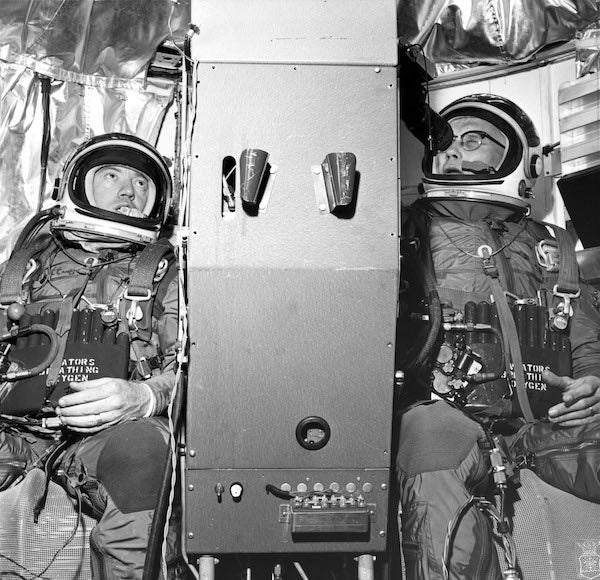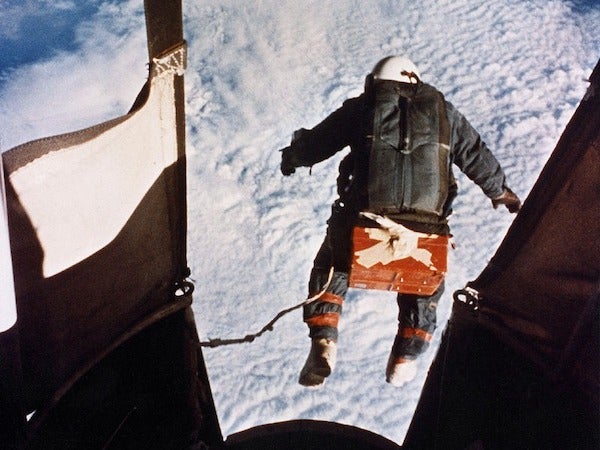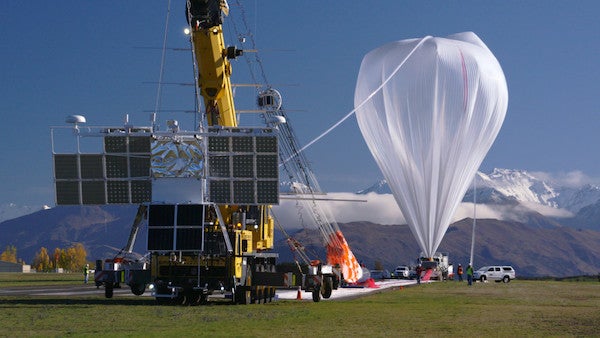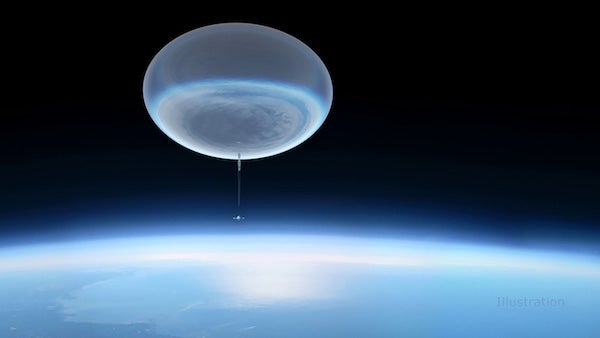On the morning of December 13, 1962, a Navy astronomer and an Air Force captain stepped out of the New Mexico Sun and into a small steel capsule attached to a nearly 300-foot-tall mylar balloon. Inside was a small research telescope and a suite of custom instruments designed to study the cosmos. Their trip was the culmination of a years-long project, first started in 1957, that aimed to show that high-altitude balloons could be used to observe the cosmos, far from most of the interference of Earth’s twinkle-inducing atmosphere.
Over the course of the next 18.5 hours, the mission, called Project Stargazer, climbed to a staggering 82,000 feet (25 kilometers) in altitude and drifted above the desert. Only a handful of crewed balloon flights had ever reached greater heights. For the two men on board, William White and Joseph Kittinger, this was supposed to be just the beginning of a bright future for balloon-borne astronomy.
But despite their best efforts, Project Stargazer lost funding, leading to the cancellation of all but one of the mission’s four planned crewed flights. And ultimately, that single flight marked the end of a brief era of high-altitude, crewed balloon flights.
You see, NASA and its fledgling Mercury Program had put John Glenn in orbit just six months before Stargazer’s flight. And by the early 1970s, balloon-based experiments had given astronomers enough confidence to start launching artificial satellites with telescopes and other instruments into low-Earth orbit.
Yet, in just the past decade, high-altitude balloons have seen something of a renaissance — and this time, instead of humans at the helm, the flights are fully robotic. Results published earlier this year show that modern balloon-borne observatories are now approaching resolutions once only possible with orbiting observatories. That means balloons could soon give the same space telescopes that replaced them a run for their money.
Project Stargazer Takes Flight
Project Stargazer was a joint effort between the U.S. Navy, Air Force, the Massachusetts Institute of Technology, and the Smithsonian Institution in Washington, D.C. Begun just a year before the creation of NASA, the project’s engineers and scientists had to develop a way to mount a working telescope to the roof of a balloon’s gondola.
This was no easy feat. The telescope was exposed to the open air of Earth’s upper atmosphere. Plus, a balloon drifts, spins and tilts, meaning that engineers had to figure out how to stabilize and point the telescope while it was moving unpredictably.
A few other efforts had already managed to successfully mount telescopes to balloons. These early balloon flights managed to image the Sun in unprecedented detail, as well as make high-resolution observations of the larger cosmos that were hard to get from ground-based telescopes.
White was a veteran of one of these earlier efforts. He had served in the Air Force during World War II before going on to study astronomy at The Ohio State University. Soon afterward, he found himself working as a naval researcher on Project Strato-lab, which was being used to pioneer new experiments in the upper atmosphere and test the technology needed to keep humans alive at those altitudes. The Strato-Lab team was laying the groundwork for humanity’s move to orbit.
White’s role on the project was to help develop scientific instruments that could be attached to the outside of the balloon gondola to measure radiation exposure — and the larger team’s efforts were successful. The data they gathered showed that astronauts would be subjected to high-energy particles from solar flares, which could harm their bodies. In fact, a version of the suits worn by the Strato-Lab pilots would ultimately be chosen for NASA’s Mercury astronauts.
The final Strato-Lab flight came on May 4, 1961, when Malcolm Ross and Victor Prather ascended to 113,000 feet in an open-air gondola with a “temperature-control system” that amounted to a pair of Venetian blinds. Nonetheless, the mission was initially successful, providing the most intense test yet of the spacesuit prototype. But tragically, Prather drowned as the men were recovered from the gondola at sea. And unintentionally throwing salt on the wound, the next day, NASA launched the first American into space, Alan Sheppard, breaking the Ross and Prather’s briefly held record for highest U.S. altitude flight.
Much like test pilots for aircraft at the time, test pilots for balloons likewise had incredibly dangerous jobs. Anyone who undertook the journey understood the risks.
Previous balloon-borne efforts had focused on the Sun. But during the first crewed Project Stargazer flight, the men managed to point the telescope and track other distant stars. And afterward, the team felt they’d made a strong case for the future potential of balloon-borne observatories. However, during their second attempt in 1963, Stargazer’s balloon broke free from the gondola while it was still on the ground. The military cancelled the project’s funding shortly after.
Meanwhile, over at NASA, the agency had already begun launching the first space-based observatories. These orbiting telescopes quickly proved capable of staying stable for many years with just a few thrusters and some gyroscopes. They also didn’t risk human lives.
A Renaissance in Balloon-Borne Astronomy
In recent years, thanks to modern electronics and software, balloon flights for astronomical research have made a resounding comeback. New kinds of balloons guided by new navigation software are now able to stay afloat longer than ever before. And with no human on board, the instruments can keep observing for weeks and even months as the balloons are carried through Earth’s atmosphere by high-altitude winds.
There, they float above all but a thin slice of Earth’s atmosphere, offering nearly space-like views of the stars and cosmos. These projects are proving that it’s possible to achieve results comparable to those of space telescopes at just a fraction of the time and cost.
For example, in 2019, a balloon experiment called SuperBIT — the Super-pressure Balloon-borne Imaging Telescope — managed to take images with a resolution approaching that of the legendary Hubble Space Telescope, according to reporting by Science. And the team behind SuperBIT says they hope to launch an even bigger telescope next year, with plans to keep it aloft for months at a time.
SuperBIT is far from alone, too. The past decade has seen balloon projects like: SuperTIGER, which studies cosmic-ray origins; BLAST, a floating telescope revealing interstellar dust and magnetic fields; and Spider, a balloon that observes the Cosmic Microwave Background in hopes of understanding the universe’s earliest moments. Each of these projects floats above Antarctica, where they can stay aloft for weeks or months.
The longer these instruments can stay afloat, the more practical they become as rivals to space telescopes. NASA is also developing so-called super pressure balloons, which can serve extra-long stints above the clouds. The technology was first used by the Soviet Union in the 1980s to help keep a balloon afloat in Venus’ atmosphere. And in 2019, after years of advancement, NASA launched a pumpkin-shaped super pressure balloon the size of a sports stadium over Antarctica carrying the TRAVALB-2 experiment. It stayed in Earth’s atmosphere for almost 150 days.
Earlier this year, Loon — a subsidiary of Google’s parent company, Alphabet, that aims to offer internet services to rural area — managed to keep one of its super pressure balloons afloat in the stratosphere for 312 days as it circumnavigated the globe. And last week, in a paper published in the journal Nature, Loon revealed an experiment that saw one of its balloons guided by Google-developed artificial intelligence, which learns as it goes, similar to the program AlphaGo. The AI managed to select balloon routes far more efficiently than the existing human-designed algorithm, ultimately saving the craft valuable power.
It’s a sign that even after more than a half-century of development, there’s still plenty of room for balloons to expand into their role: operating near the edge of space.













